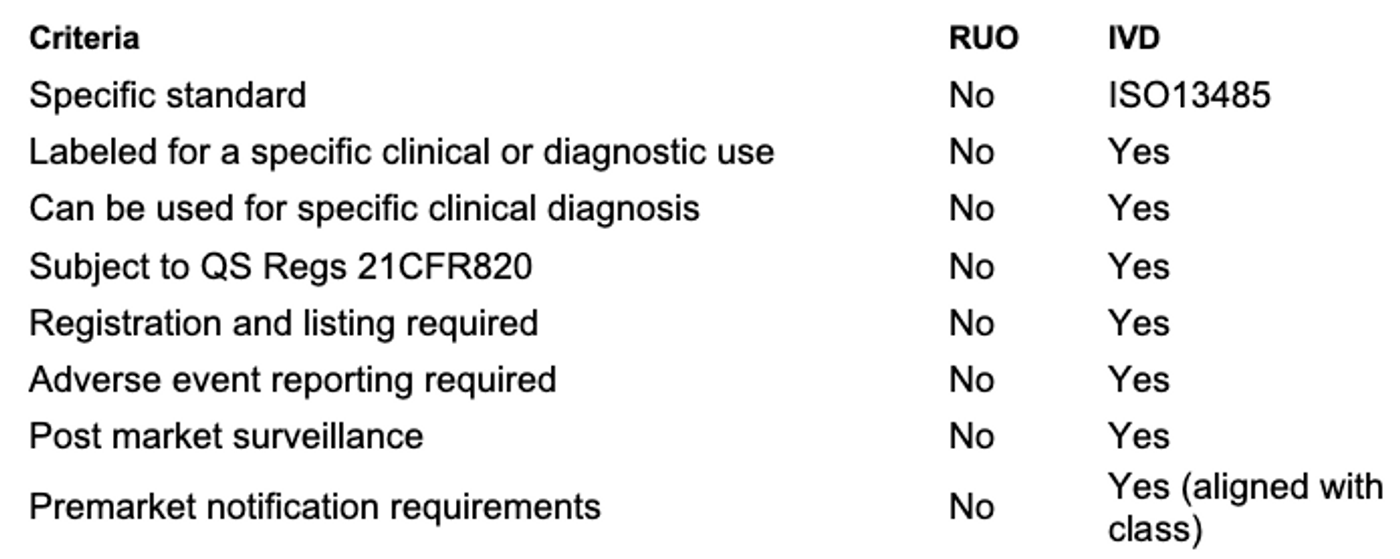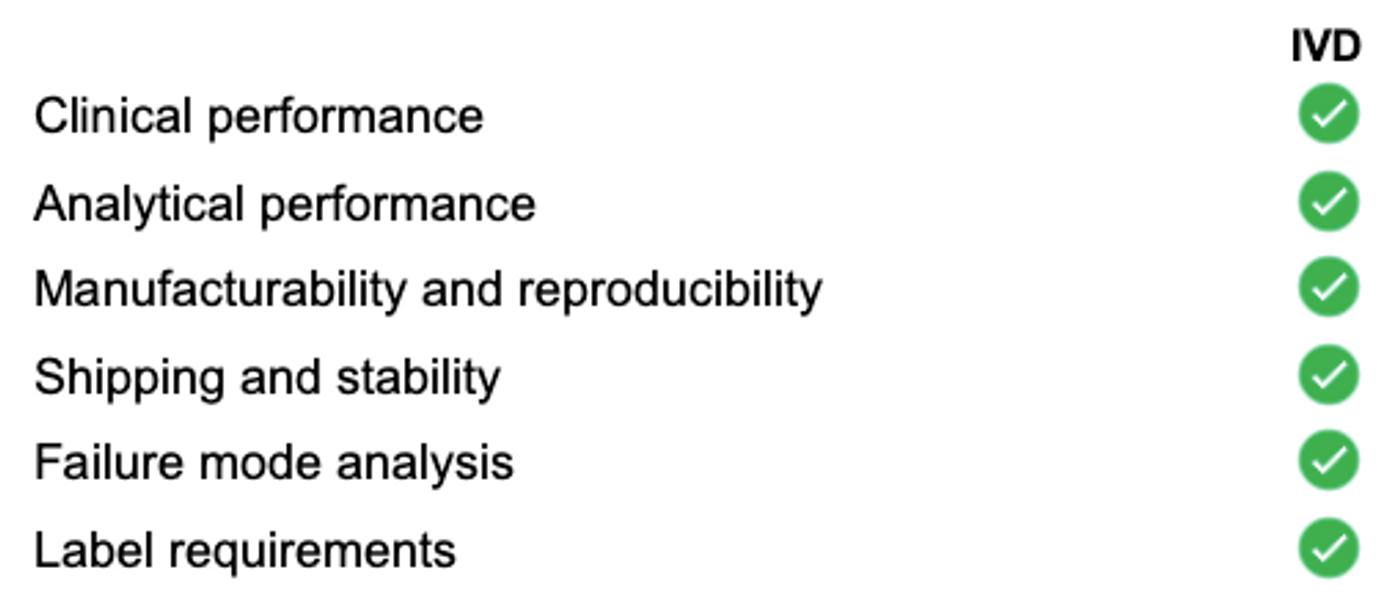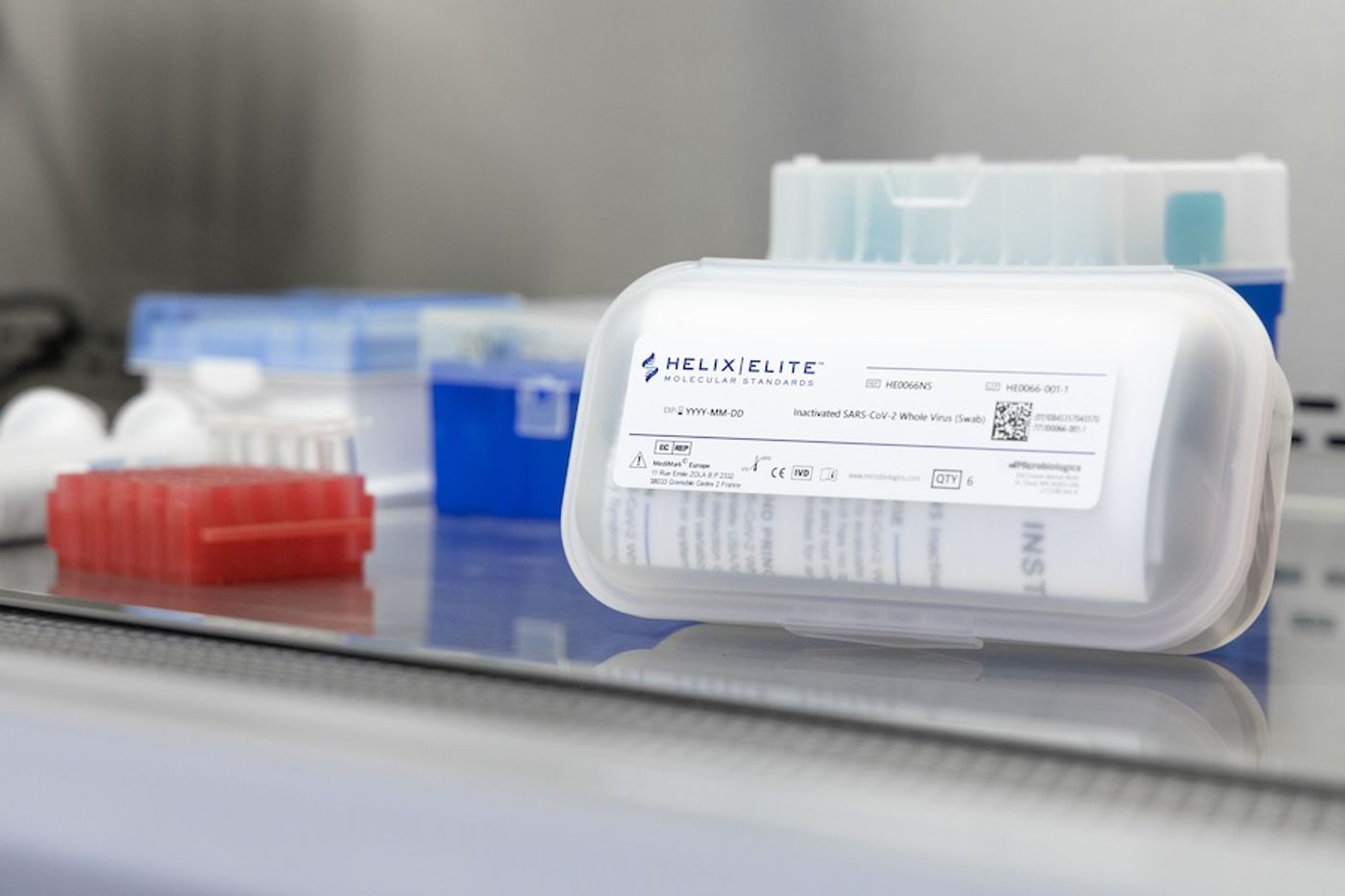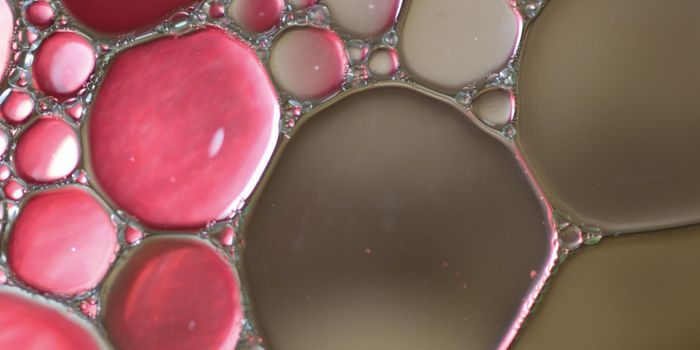IVD Versus RUO in The Clinical Laboratory
This article is the third in Microbiologics’ series on Optimal QC in the Clinical Laboratory.
Previously, in this series we highlighted the importance of external and third-party quality control products in the clinical laboratory, emphasizing that quality control, by design, should add layers of removal from the assay to ensure the utmost degrees of objectivity. External, third-party quality control materials fulfill this QC requirement by removing bias in the quality control process. However, in addition to adding objectivity to the quality control process, it is critical that clinical laboratories consider the quality and the regulatory status of their quality control products.
The IVD and RUO labels are so commonplace in diagnostic laboratories that they easily go unnoticed. Clinical laboratory professionals may not pause to remember that these labels stand for In Vitro Diagnostics (IVD) and Research Use Only (RUO). Even clinical laboratory professionals who are familiar with these regulatory designations for assays or instruments sometimes do not realize the full significance that these labels have for certain products, including quality controls. Therefore, even though the quality and the regulatory status of quality control products is essential to consider, many clinical laboratories may not know the status of their quality control materials and products. This lack of understanding inadvertently puts both patients and the clinical laboratory at risk.
This blog post will examine the differences between RUO and IVD and the importance of choosing the right quality control products in the clinical laboratory. For additional information on RUO and IVD, check out our webinar highlighting the critical differences between RUO and IVD and the importance of choosing the right clinical diagnostic products. We partnered with CAP Today and industry expert Dr. Sebastian Grömminger to bring you this webinar.
Research Use Only (RUO)
RUO stands for Research Use Only. The RUO label serves as a warning to clinical laboratory professionals that the materials in question are not intended for use with patient diagnostics. RUO products are in the laboratory phase of development and must have no intended medical purpose or objective, as these materials do not require validations or regulatory compliance.2 RUO materials are not defined in the EU’s In Vitro Diagnostic Medical Devices Regulation (IVDR) and do not have any regulatory requirements. Therefore, RUO materials are to be used only for testing with no direct impact on patient diagnostics.
According to United States Food and Drug Administration (FDA),3
- Similar to the case in the EU, RUO refers to products in the “laboratory phase of development,” which are “not approved for clinical diagnostic use”
- RUO products are “exempt from most regulatory controls,” so it is therefore “important that they are not distributed for clinical diagnostic uses”
- All product labeling for these products must bear a prominent user notification: “‘For Research Use Only. Not for use in diagnostic procedures.’”
- RUO Labeling is intended to “serve as a warning, to prevent such products” from being used in manners that will impact patient testing and treatment outcomes.
- Companies selling RUO materials are limited in their marketing in some regions. In these regions, manufacturers may be forbidden from providing technical support for RUO materials. Availability of technical support is thus an important advantage of IVD products. Since the clinical diagnostic field is complex, having experts to rely on is an indispensable service exclusive to IVD controls.
Since RUO materials are in the laboratory phase of development, their inappropriate use in clinical diagnostics may pose unnecessary threats to diagnostic precision, laboratory efficiency, operating margins, and risk management systems. Therefore, clinical laboratories should not use these materials for reporting patient results. Thus, the RUO label is a warning to the clinical laboratory professional that this material is not intended for use in clinical diagnostics. Rather than using the RUO material, a clinical laboratory professional should look for the right IVD product for any test that could directly impact patient health outcomes.
In Vitro Diagnostic (IVD)
IVD stands for In Vitro Diagnostic. In contrast to RUO, according to global regulations and standards, IVD products are used for medical applications or purposes. According to the FDA, “In vitro diagnostic products are those reagents, instruments, and systems intended for use in diagnosis of disease or other conditions, including a determination of the state of health, in order to cure, mitigate, treat, or prevent disease or its sequelae. Such products are intended for use in the collection, preparation, and examination of specimens taken from the human body.”4 According to the IVDR in the European Union and the UK Medicines and Healthcare Products Regulatory Agency (MHRA), IVD medical devices have a medical application or purpose.4
IVD products must undergo extensive validations to be registered by the FDA, IVDR, and the MHRA. Registrations are required in most countries. Table 1 highlights the regulatory criteria comparison between IVD and RUO products. As shown in the table, IVD products are subject to numerous regulatory requirements, from labeling to post-market surveillance.6,7 RUO materials do not share these requirements, thus laboratories using RUO materials take on increased risk.8
Since the manufacturer of the IVD product has invested in extensive studies to validate the performance of IVD product, the clinical laboratory can benefit by reducing the validations required on part of the clinical laboratory. Laboratories choosing to use RUO materials will need to perform more extensive validations than those using IVD products. Thus, clinical laboratories choosing RUO materials take on increased risk and must invest more time into validation and documentation efforts.
Table 1. IVD vs. RUO Regulatory Criteria Comparison. As shown in the table, IVD products are subject to numerous regulatory requirements from labeling to post market surveillance. RUO materials do not share these requirements, thus laboratories using RUO materials take on increased risk.
IVD products also have stringent product development requirements according to IVDR and FDA as shown in Table 2. IVD products have requirements for clinical performance, analytical performance, manufacturing and reproducibility, shipping and stability, failure mode analysis and labeling requirements. RUO materials do not specify requirements for these processes. Again, IVD products are required to demonstrate stringent performance characteristics and regulatory requirements whereas RUO materials do not.
Table 2. IVD: Product Development Requirements. Here we see the product development process requirements under IVDR and FDA for IVD Designation. The IVDR is aligned with FDA here. As shown in the table, IVD products have requirements for clinical performance, analytical performance, manufacturing and reproducibility, shipping and stability, failure mode analysis and labeling requirements. RUO materials do not specify requirements for these processes.
As mentioned above, the unavailability of technical support for RUO materials in certain regions may further limit their ability to fulfill the demands of quality control in clinical settings. Since quality control aims to provide confidence in the laboratory’s analytical processes, QC must bring together the right technical expertise and the right products. Given the complexity of clinical diagnostics, technical support is an indispensable service offered by IVD manufacturers.
Sometimes, IVD products may not be available for a particular assay. In certain cases, non-IVD-labelled products may be permissible in clinical diagnostics, such as when testing materials receive Emergency Use Authorizations because IVD products are not yet available. When used in these extenuating circumstances, non-IVD-labelled products will require the laboratory professional to perform additional steps to satisfy regulatory demands for quality control.
Summary
Quality controls help reveal blind spots, biases, material defects, and other causes of inaccurate diagnostic results. By design, quality control allows the clinical laboratory to test their analytical processes in a controlled manner to ensure assays and instruments perform as expected before their use for patient samples. Because approximately 70% of healthcare decisions rely on the results of laboratory testing, accurate diagnostic processes are critical to patient care. Therefore, quality control is foundational to the quality management system of a clinical laboratory, and its role cannot be understated.
Because of this critical role, clinical laboratories must not only use quality control materials with an intended use in clinical diagnostics, but also must choose products meeting the highest standards for quality, precision, and scientific rigor. When clinical laboratories choose an IVD product, they put their confidence not only in the regulatory status of the material for use in clinical diagnostics, but also confidence that manufacturer has invested time and care to ensure the product has been properly validated and subject to stringent quality requirements before its release as a product offering.
Clinical laboratories should keep in mind that, according to global regulations (e.g., European Commission, FDA, etc.), RUO materials have no place in routine clinical diagnostics. Clinical laboratories that choose to use RUO materials are putting their patients and laboratory at risk. In addition to not having an intended use in clinical diagnostics, RUO materials are exempt from most regulatory controls which may impact product quality. Additionally, a lack of technical support may intensify these drawbacks.
Choosing IVD quality control products is essential in the clinical laboratory as these products have undergone extensive validations required to be registered with FDA, European Commission, MHRA, and other regulatory bodies for an intended use in clinical diagnostics. An IVD label signifies exactly what you look for in an external, third-party control: uncompromising quality, according to the highest standards. The IVD label represents product quality and confidence and strengthens the clinical laboratory’s risk management program. The IVD label allows technical support assistance. Reliance on a reputable third-party, IVD quality control manufacturer gives back the clinical laboratory time, money, and peace of mind.
IVD Controls from Microbiologics
The Microbiologics portfolio of molecular QC brings external, third-party, IVD objectivity to a broad range of instruments and assays. We offer molecular controls for the major syndromic groups of infectious disease, including respiratory, GI, Women’s Health & STI, HAI, and more.
Sources
- European Commission. (2004, February). Guidance document – In vitro diagnostic medical devices – Research Use Only products – MEDDEV 2.14/2 rev.1. European Commission. https://ec.europa.eu/docsroom/documents/10292/attachments/1/translations
- Center for Devices and Radiological Health. (2013, November 25). Distribution of In Vitro Diagnostic Products Labeled for Research Use Only or Investigational Use Only. Guidance for Industry and Food and Drug Administration Staff. U.S. Food and Drug Administration. https://www.fda.gov/media/87374/download
- Center for Devices and Radiological Health. (2013, November 25). Distribution of In Vitro Diagnostic Products Labeled for Research Use Only or Investigational Use Only. Guidance for Industry and Food and Drug Administration Staff. U.S. Food and Drug Administration. https://www.fda.gov/media/87374/download
- Center for Devices and Radiological Health. Overview of IVD Regulation. U.S. Food and Drug Administration. Retrieved March 6, 2023, from https://www.fda.gov/medical-devices/ivd-regulatory-assistance/overview-ivd-regulation
- Regulation (EU) 2017/746 In Vitro Diagnostic Medical Devices (IVDR) https://eur-lex.europa.eu/legal-content/EN/TXT/HTML/?uri=CELEX:32017R0746&from=EN
- Center for Devices and Radiological Health. (2021, October 21). Overview of IVD Regulation. U.S. Food and Drug Administration. https://www.fda.gov/medical-devices/ivd-regulatory-assistance/overview-ivd-regulation#1
- 21CFR809, Subpart B, In Vitro Diagnostic Products for Human Use. https://www.accessdata.fda.gov/scripts/cdrh/cfdocs/cfcfr/CFRSearch.cfm?CFRPart=809&showFR=1
- Grömminger, S. (2022, May 25). Laboratory Products for “Research Use Only” (RUO) – Often a Dangerous Claim. Johner Institut. https://www.johner-institute.com/articles/regulatory-affairs/and-more/laboratory-products-for-research-use-only-ruo-often-a-dangerous-claim/













